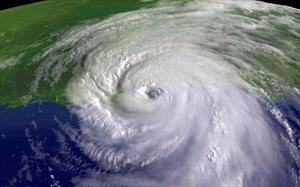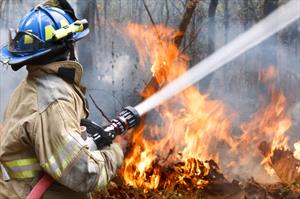Hurricane Katrina

Photo courtesy of Depositphotos
I remember being in a meeting years ago and hearing an estimate of the number of deaths of people from Hurricane Katrina that were linked to them staying behind because they could not evacuate their pets. People chose to ride out a devastating hurricane rather than abandon their animals – animals that weren’t part of the evacuation plans. I can’t remember the number, but it floored me.
Many people died because they wouldn’t leave their animals to die. Additionally, it was estimated that 100,000-600,000 pets were left behind. I’m not sure there’s any reasonable estimate of how many of those survived. Certainly, many did not.
These tragic numbers are preventable, or at least can be massively reduced, but it’s not easy.
Wildfire and firefighter

Photo courtesy of Depositphotos
To be sure, there are many challenges with evacuating large numbers of animals – logistical challenges, animal health and welfare challenges, and public health challenges (e.g. bites from poorly behaved or stressed animals, fear of animals amongst other evacuees, risk of zoonotic disease transmission). Challenges mean we need to plan, not just ignore the issue.
Anyone, anywhere can be affected by a natural (or unnatural) disaster, so everyone should have a plan for what to do with their animals. The disaster might be a high profile, mass event like a hurricane or forest fire, or it might be an individual-level event like a house fire.
The U.S. Centers for Disease Control and Prevention (CDC) has some good guidance for emergency preparedness for pets, including a pet disaster checklist.
While sometimes a disaster plan might be how to ride it out on your own, or with family or friends, or in a hotel, sometimes disasters require people to go to evacuation centres and shelters. That’s where the big challenges lie, when pets need to be evacuated as well. Balancing animal health and welfare and human health during a chaotic time, when the health of pets is far from the top of the priorty list is difficult, but it’s doable.
Planning in advance is the key. Trying to come up with a plan during a disaster rarely works well, especially when the plan is for something peripheral to the disaster (like pets).
Things that need to be considered include (but are not limited to):
- What animal species can be taken in?
- How are the animals transported?
- How can the animals be housed?
- How will they be cared for, and by whom?
- How can the animals be identified/documented so they can stay with their owners or be re-united later if separated?
- Is veterinary care available?
- How are other people with allergies or fear of animals accommodated?
Why is emergency preparedness for pets important?
- We need to ensure that people take the opportunity to safely evacuate. If they don’t, they might die unnecessarily. Additionally, people who try to ride things out may put rescuers at risk if they have to come back to do a high risk removal.
- We need to make sure that adding animals to evacuation plans doesn’t result in unnecessary problems for evacuees and support personnel, including injuries and illness.
- We need to remember the critical role pets may play during the stress of evacuation and the disaster itself. Removing what for some people may be their main emotional support mechanism at the time they need it most needs to be avoided.
All organizational levels need to be involved in this kind of planning, but support from the top in essential. In response to hurricane Katrina, the PETS Act (Pet Evacuation and Standards Act) was passed in the U.S. in 2006.
This Act links the ability of states to receive federal funding for their disaster relief plans to inclusion of the needs of individuals with pets or service animals in those plans. It provides a mechanism for FEMA funding of pet-friendly emergency shelters and supporting the needs of pets in these situations.
Other countries need to take similar actions, and make sure animal needs are built into emergency preparedness plans. Funding is part of it, but it’s even more important to support the need for planning and to empower the people who want to make it work.
Reprinted with permission from Worms and Germs Blog.